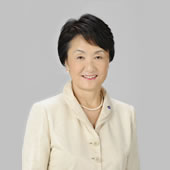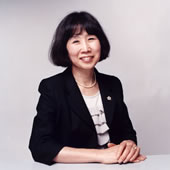
I am delighted to announce the long-awaited opening of the Yokohama Triennale 2011.
Since the Great East Japan Earthquake of March 11 up until today, we have been extremely fortunate to be blessed with the support and assistance of many people. In particular, we have received many heartening messages from all participating artists, including those from abroad, who have expressed their desire to come to Japan to make this Triennale a reality. I have been extremely grateful and moved by their desire to help Japan get back on its feet and recover from this disaster.
This yearʼs fourth edition of the Triennale has been designated by the Agency for Cultural Affairs as an incubator project for International Arts Festivals in Japan. The Yokohama Triennale 2011 is therefore poised to carry on the tradition and history of this festival as a project on a national scale.
In addition, we have been fortunate to receive the help and cooperation of many other institutions and individuals in a variety of forms. I would like to take this opportunity to express my sincere gratitude to all those involved, and look forward to their continued support throughout the duration of the Triennale.
Let me take a few moments to introduce you to some of the unique features of this yearʼs Triennale.
One of the main venues for the exhibition, with its theme “OUR MAGIC HOUR–How Much of the World Can We
Know?”, is the Yokohama Museum of Art. The Museum possesses rich holdings of art dating from the latter half of the 19th century, in addition to a rare and valuable photography collection that befits Yokohamaʼs status as the birthplace of Japanese photography. I have been wanting to make use of this prominent arts institution as a key venue for the Triennale for some time, and I am delighted to be able to say that we have succeeded in using it as a platform for the festival this year.
In addition, the NYK Waterfront Warehouse – a hub for contemporary art that is more commonly known as BankART Studio NYK – is truly a building rich in historical associations proper to Yokohamaʼs status as an important Japanese port city. Personally, I look very much forward to seeing how contemporary art will be showcased in these unique, distinctive spaces.
Another standout feature of the Triennale is the way in which it has helped to promote a model of urban planning and renewal that taps the resources of Yokohamaʼs historical buildings and architecture. With the cooperation and support of various artists who have gathered in Yokohama, the city will come alive with an extravaganza of art and related programs and events throughout the duration of the Triennale.
Also being held in conjunction with this yearʼs Triennale over the same period will be “Open Yokohama 2011”, a promotional tourism initiative that highlights the wealth of the cityʼs most spectacular sights. During this period, we look forward to welcoming visitors from all around the world with the warmest hospitality.
We cordially invite you to join us on this three-month festival that opens a window onto the wonder and mystery of the world, promising all visitors magical, exciting encounters with contemporary art.
- HAYASHI Fumiko
- Mayor, City of Yokohama
- President, Organizing Committee for Yokohama Triennale
 Photo : RISAKU Suzuki
Photo : RISAKU Suzuki
It is with great pleasure that we open Yokohama Triennale 2011 “OUR MAGIC HOUR—How Much of the World
Can We Know?”
This year represents a turning point for the Yokohama Triennale. With its main organizer changing from the Japan Foundation to City of Yokohama, and with the Yokohama Museum of Art for the first time becoming the
triennaleʼs main venue, the fourth edition, will be very different to the previous three.
We feel that Yokohama, which since the opening of its port to the world in 1859 has developed in step with the modernization of Japan, is particularly suited to holding an event of this nature. Festivals of contemporary art
serve to illuminate contemporary society and human existence. Yokohamaʼs suitability is also demonstrated in its openness to new ways of thought and expression and its acceptance of interaction between diverse peoples, cultures and values.
The guiding principle behind Yokohama Triennale 2011 is “look, nurture and connect,” and in following this principle we have endeavored to convey as widely as possible the diverse potential of contemporary art.
Through presentations that take advantage of the unique characteristics of our two main venues – Yokohama Museum of Art and NYK Waterfront Warehouse (BankART Studio NYK) – and also satellite venues, such as the
Yokohama Creativecity Center (YCC), the experience of “looking” at the artworks will be made more profound, and visitors will be able to taste the joy of interpreting artworks by embarking on a journey through time and
place and deep into their imaginations. Also, as a part of the “nurturing” aspect of the triennale, we have a Junior Program to provide young audience a meaningful experience, and also the Special Supporters Program to share our experience with guests from professions outside contemporary art.
Also, the attempt to “connect” the main venues with a variety of other events and genres is also a new aspect of the triennale. Through collaborations with various unique NPOs, cultural institutions and universities, we have attempted to broaden the appeal of the triennale by preparing programs that cover not just art but music, theater, film and traditional performing arts. To improve convenience for visitors and also strengthen links with the main venues, we have established a special joint ticketing policy for Special Tie-Up Programs, BankART Life III and
Koganecho Bazaar 2011.
Five months have passed since the Great East Japan Earthquake, and we would like to think that with art we can make even a small contribution to the forward momentum in overcoming this challenge. There is artwork on display that visitors will be able to donate to charity through their participation. There will also be a talk aimed at deepening understanding of the situation in the tsunami-affected areas.!
We hope that the ability to see and know the world with nuance and complexity – an ability that we believe is enhanced through the appreciation of contemporary art – will, like magic, shine a ray of light on what remains a difficult and complex road forward.
- OSAKA Eriko
- Director General
- YOKOHAMA TRIENNALE 2011
- Director General, YOKOHAMA TRIENNALE 2011 / Director, Yokohama Museum of Art OSAKA has organized and curated many international exhibitions of contemporary art while at the Japan Foundation and ICA, Nagoya. She was senior curator (1994-1997) and artistic director (1997-2006) at the Contemporary Art Center, Art Tower Mito, artistic director at Mori Art Museum (2007-2009) before assuming her current position as director of Yokohama Art Museum. She has received BFA in Aesthetics/Art History from Department of Philosophy, Faculty of Letters, Gakushuin University.


